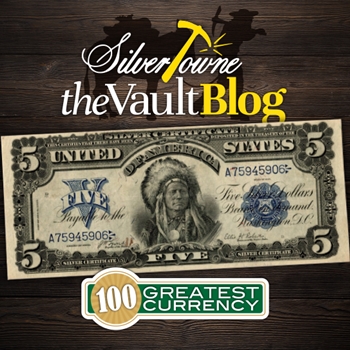
It is not a coincidence that two large size Silver Certificates with a $5 denomination have been deemed worthy of the top 10 in Whitman Publishing’s 100 Greatest American Currency Notes. While we have already covered one (the Educational Note of 1896 [#5]), the second we will explore alongside authors Q. David Bowers and David M. Sundman.
#10 – Series of 1899 $5 “Indian Chief Note” Silver Certificate
This 1899 $5 Silver Certificate features a portrait of an Indian Chief on the face. It is said to be Running Antelope, a member of the Sioux tribe. However, the type of headdress he is said to be wearing, according to Gene Hessler in his Comprehensive Catalog of U.S. Paper Money, is not correct. The headdress depicted is a Pawnee war bonnet and not Sioux. This mistake created ill will among Native Americans at the complete lack of awareness the Bureau of Engraving and Printing had, noting the bills as offensive.
The “Indian Chief Notes” were produced for several years. They are popular among collectors and appeal to a wider audience due to the era in which they circulated. This era was the Wild West and the theme ended up on several pieces of United States currency and coinage. This included traveling shows featuring cowboys, Indians, horses, cattle, buffalo hides, and more.
In 1960, this note in a Gem Crisp Uncirculated condition has a historic market value of $35. By this publication (2006), that value rose to $4,000.







